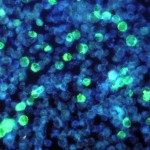Lien vers Pubmed [PMID] – 15187148
J. Immunol. 2004 Jun;172(12):7661-8
The mechanism of IL-2-induced vascular leak syndrome (VLS) is still poorly understood. Cells of both innate and adaptive immune systems have been implicated, but no definitive conclusions have been reached concerning their respective roles. In this study we report a new mouse model of IL-2-induced pulmonary VLS used to obtain a detailed analysis of the early events (sequestration of polymorphonuclear neutrophils and bronchoconstriction) and late events (modifications in the cell and protein content of bronchoalveolar lavages, followed by edema) that characterize this lung injury. This model and knockout animals are used to reconsider the importance of the different leukocyte lineages in early and late events. Recombinase-activating gene 2(-/-) mice are used to demonstrate that adaptive lymphocytes, including NK T cells, are not required for pulmonary VLS induction. By contrast, results obtained with newly described recombinase-activating gene 2(-/-)/IL-15(-/-) mice indicate that NK cells play a key role in both early and late events. In parallel, polymorphonuclear neutrophil depletion is used to evaluate the contributions made by these cells to the late alterations occurring in the lung. Furthermore, when used in combination with inhibition of NO synthase, granulocyte depletion was completely effective in protecting mice from the late events of IL-2-induced pulmonary VLS. Together our results indicate that both NK and PMN cells play a central role in the late events of IL-2-induced VLS.

